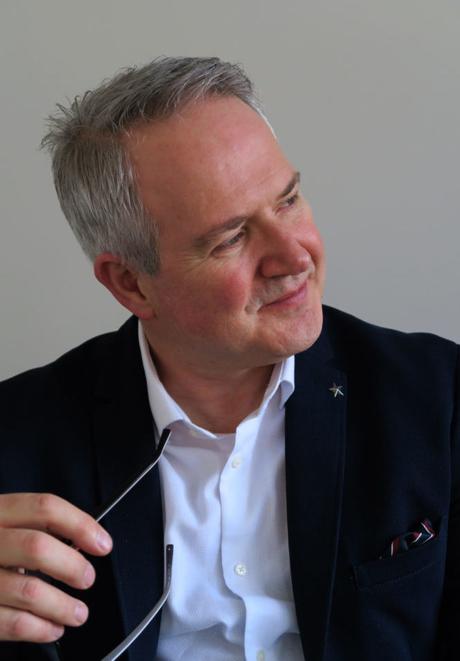April 2, 2023
Sustainable energy storage for the future – underground
The Hagerbach Test Facility (VSH) in Switzerland is home to the SubSpace Energy Hub. The Hub will transform VSH into a sustainable, CO2 neutral facility to develop underground space usage. Normet has been heavily involved in the project from the beginning, says Ross Dimmock, Vice President Tunnelling, in this interview.
Hi Ross. Thanks for taking the time to tell us about the SubSpace Energy Hub. Can you start by telling us what it is and what Normet have to do with it?
Normet is one of eight companies that have initiated the project called SubSpace Energy Hub. Companies involved in tunnel and mine construction have been talking about improving the sustainability of their operations for many years. After the Paris Agreement in 2015, the idea of reducing carbon emissions to net zero by 2030 became prominent. We’ve started seeing the transition in everyday life with electric cars and wind farms and the like. With our partners, Normet thought it was time to start walking the talk, so to speak, so the SubSpace Energy Hub project was founded in 2022.
The hub is being created at VSH – a series of caverns and tunnels in the Swiss Alps – as a kind of underground test gallery. We’ve been testing our equipment there for several decades, and we’re joined by companies involved in battery technology, underground energy storage, and other forward-thinking technologies. It’s quite an eclectic mix, but we’re trying to get others in as well. And we started off with the question of how we fast track zero carbon in tunnelling and mining.
There are two halves to this. Firstly, it’s about the construction of these facilities. And the second half is really about energy storage and how it’s used in local communities. We want to create this test facility in Switzerland so that all interested parties can come to see it in action.
I can imagine that interest in zero carbon solutions is growing all the time.
Definitely. Industries really want to go zero or at least low-carbon but it’s not easy to know the best way to go about it. It’s complicated, with questions about how to transfer and store the energy, whether they should use AC or DC power grids, which is more efficient, and so on. These are big topics for them. So, we’re trying to actually put all these bits of the jigsaw together and create a model system that the world can come and have a look at and be inspired by.
For the companies involved it makes sense sustainably and commercially. For example, as far as Normet is concerned, we’re doing a lot of research into electric battery-operated vehicles – how efficient they are, how you run them, what their value is. In our world, mining companies in particular are open to this technology change away from traditional diesel and fossil fuel driven vehicles. There are many advantages to battery power, not least that apart from their construction, once in use the vehicles are completely carbon-neutral if run on renewable energy sources.
And these issues are seeping into the public consciousness as well.
Exactly. We’re talking about the best way to move energy around, how to stop using fossil fuels and replace them with gas and hydrogen to meet local energy needs. There’s a program to considerably reduce the amount of cement and steel we use underground, and to replace cement with more environmentally friendly material. And that’s something that’s also seeping into the public consciousness – this idea that construction as a general industry should become less CO2 and fossil fuel intensive.
So, this is something that the general public could understand and get behind in a way that they might not perhaps understand underground tunnelling methods. And if we say that we are using 30 to 40 per cent less embodied carbon in the concrete than we were a year ago thanks to our research, that’s also a tangible benefit.
And the idea is to make those kinds of initiatives the industry norm?
Yes, we want to suggest new best practices. We need to continue to harmonize best practice guidelines within the industry, stop talking about carbon reduction and level up what we are actually doing for the benefit of our society. The demand for those kinds of facilities will surely only increase. After all, no one’s going back to thinking let’s get more fossil fuels involved in this.
Finally, Ross, how do you see the future of energy supply given the way the world is changing?
Microgeneration of energy is definitely on the cards. The energy sources I’ve seen in my lifetime have been big coal fired power stations, gas powered stations, nuclear power stations. But then you’ve got companies now looking at micro nuclear plants. You have incinerators that can produce energy locally for communities. You’ve got the debate about putting wind turbines on land and bring them closer to communities. And what we’re talking about is actually doing the same with energy stored underground that can drive turbines to create local energy.
One extremely good example is Norway, where the number of 10 megawatt hydro schemes is incredible. They have thousands of them. In the future, these kinds of topics will be very important. We’re already pushing them, and these issues around renewable energy storage are also supporting us in our arguments to promote this technology in the industry.
About the author

Ross Dimock
Vice President for Tunnelling at Normet
Bio
Ross is well known to both the UK and international sprayed concrete tunnelling industry having started his journey on the NATM sections of the Channel Tunnel. There followed two separate episodes in Mott MacDonald working on Crossrail and Hindhead designs, between which he worked for Balfour Beatty on the construction of Waterloo Station Jubilee Line, and MBT later BASF as a global technical head. After 11 years with Normet in various lead roles, he now is the Vice President for Tunnelling, and has the exciting challenge to develop sustainable, low carbon solutions for the industry, pulling on his 33 years of sprayed concrete tunnelling passion and motivating change!
Ross Dimock - LinkedIn Profile
